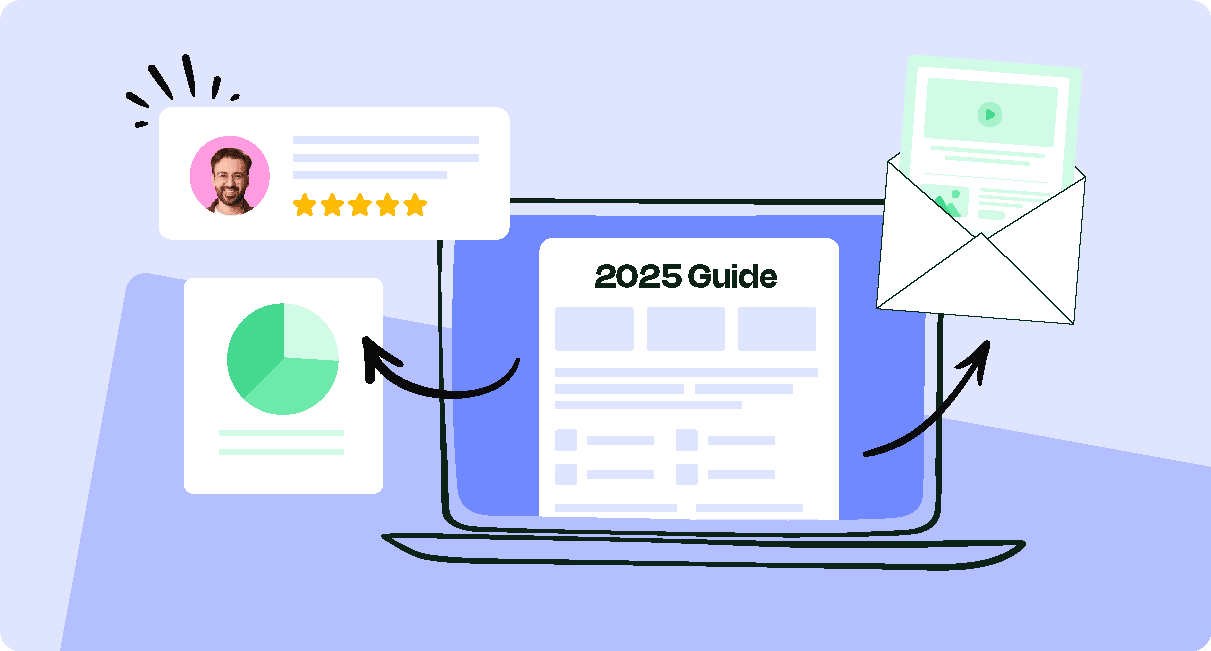Internal communicators today face more complexity than ever—hybrid work, disengaged teams, and information overload. To cut through the noise and keep employees aligned, you need more than tactics. You need a strategic approach. This guide breaks down the top 10 internal communication strategy ideas that actually work—plus real examples, the right internal comms tools and pro tips.
New to internal comms management? Don’t worry, even seasoned professionals can confuse an internal communication strategy with tactics.
To make it clear, your internal communications strategy is the big picture. It’s the long-term plan that outlines why you’re communicating, what you want to achieve, and how it aligns with your organization’s goals. An effective internal communication strategy will uphold your company’s daily operations, employee engagement, and long-term success.
Whether you’re looking to improve your internal communication system across departments or fine-tune your internal communication best practices, you’ve come to the right place. In this post, we’ll explore the 10 key elements you must include in your internal communication strategy to connect with employees, secure leadership buy-in, and keep your workforce informed and aligned.
Book a demo to see how ContactMonkey’s internal communication solutions can help you bring your IC strategies alive with email, newsletters, surveys, and analytics features.
Take a self-guided tour of ContactMonkey
See how our key features can streamline your internal communications.
Take product tour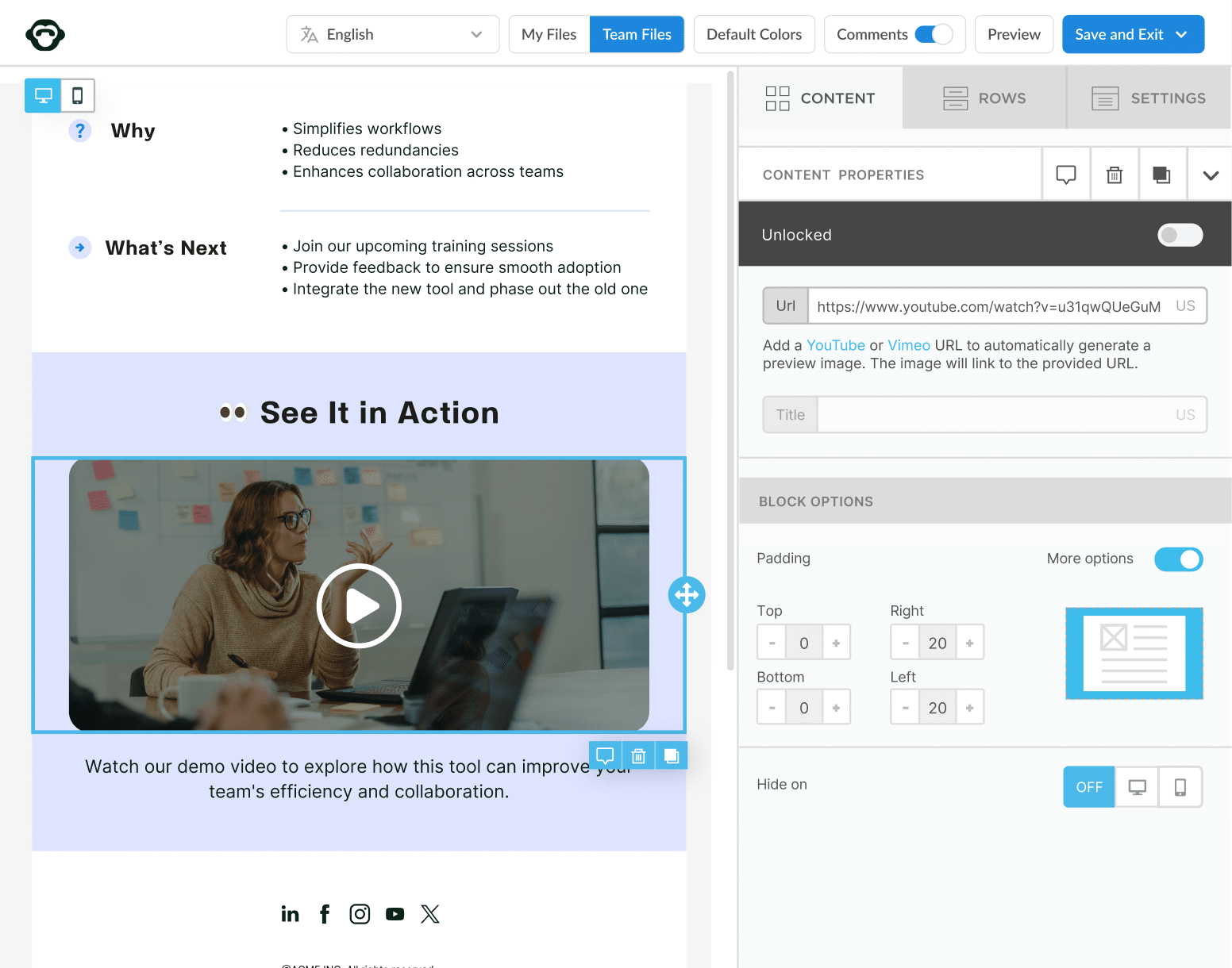
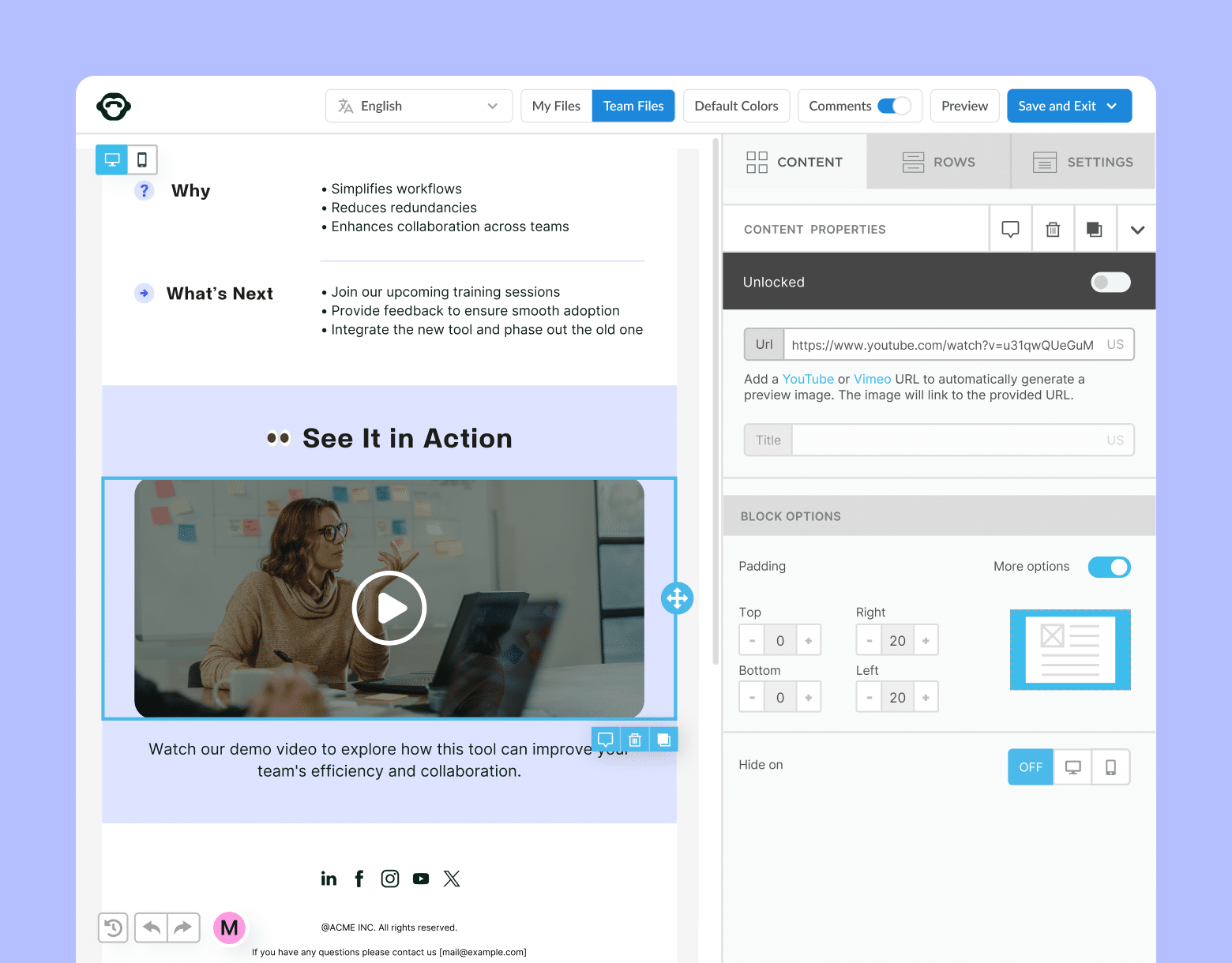
Why a Strong Internal Communication Strategy is Business-Critical in 2025
In today’s high-stress, low-engagement workplace environment, a strong internal communication strategy is key to success, especially this year.
According to Gallup’s State of the Global Workplace 2025 Report, only 21% of employees globally are engaged at work, and 40% report experiencing stress daily. This disconnect, combined with rapid workplace transformation through AI and digital disruption, means organizations can no longer afford ineffective or reactive communication.
Here’s why a great internal communication strategy is truly make-or-break in 2025:
- Improves employee engagement: Clear and transparent communication makes employees feel more connected to the company’s vision and goals, which can lead to increased job satisfaction and loyalty — critical at a time when only 21% of employees globally are engaged.
- Enhances productivity: An effective internal communication strategy ensures employees receive the right information at the right time, reducing confusion and wasted effort, and boosting productivity — especially important since 70% of team engagement is driven by managers.
- Reduces employee stress: Consistent communication reduces uncertainty, a key approach when 40% of global employees report feeling stressed daily.
- Boosts employee retention: Employees who feel informed and valued through effective communication are less likely to leave. Nowadays, this is important since 50% of employees are watching for or actively seeking a new job.
- Strengthens organizational alignment: A clear internal communication strategy ensures employees understand evolving business priorities and feel empowered to contribute, fostering better alignment in a rapidly changing environment
- Facilitates smoother change management: Strong communication reduces resistance to change, helping employees adapt during major organizational shifts like digital transformations and AI adoption.
- Builds a thriving workplace culture: Regular, meaningful communication strengthens culture, which is crucial given that only 33% of employees globally report thriving in their lives overall.
Looking for a deeper dive? Learn more about the many benefits of effective internal communication, overall.
Modern internal comms and measurement tools
No design or technical expertise needed. Save time, increase engagement, and dazzle your employees with fun and interactive communications.
Explore all features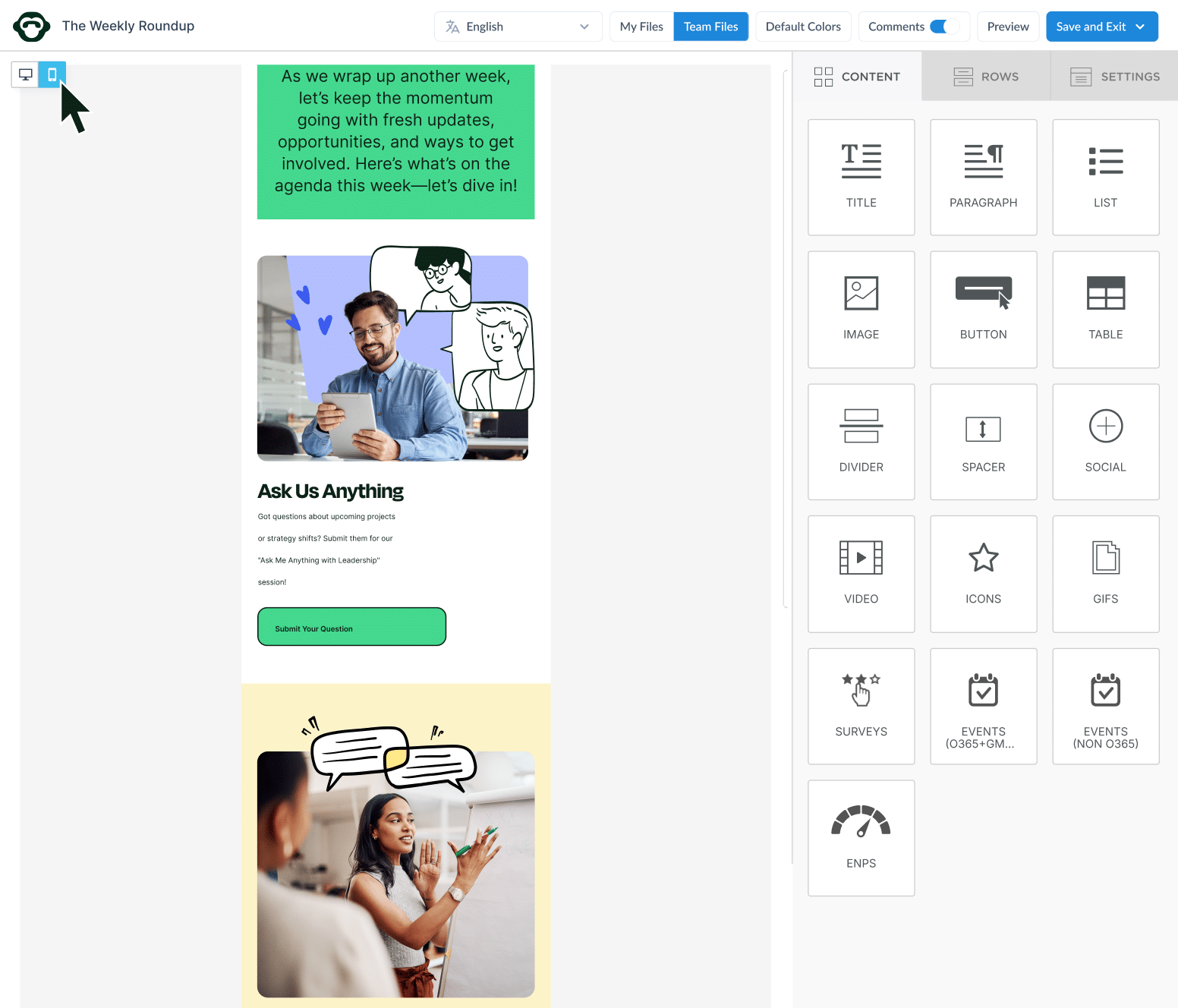
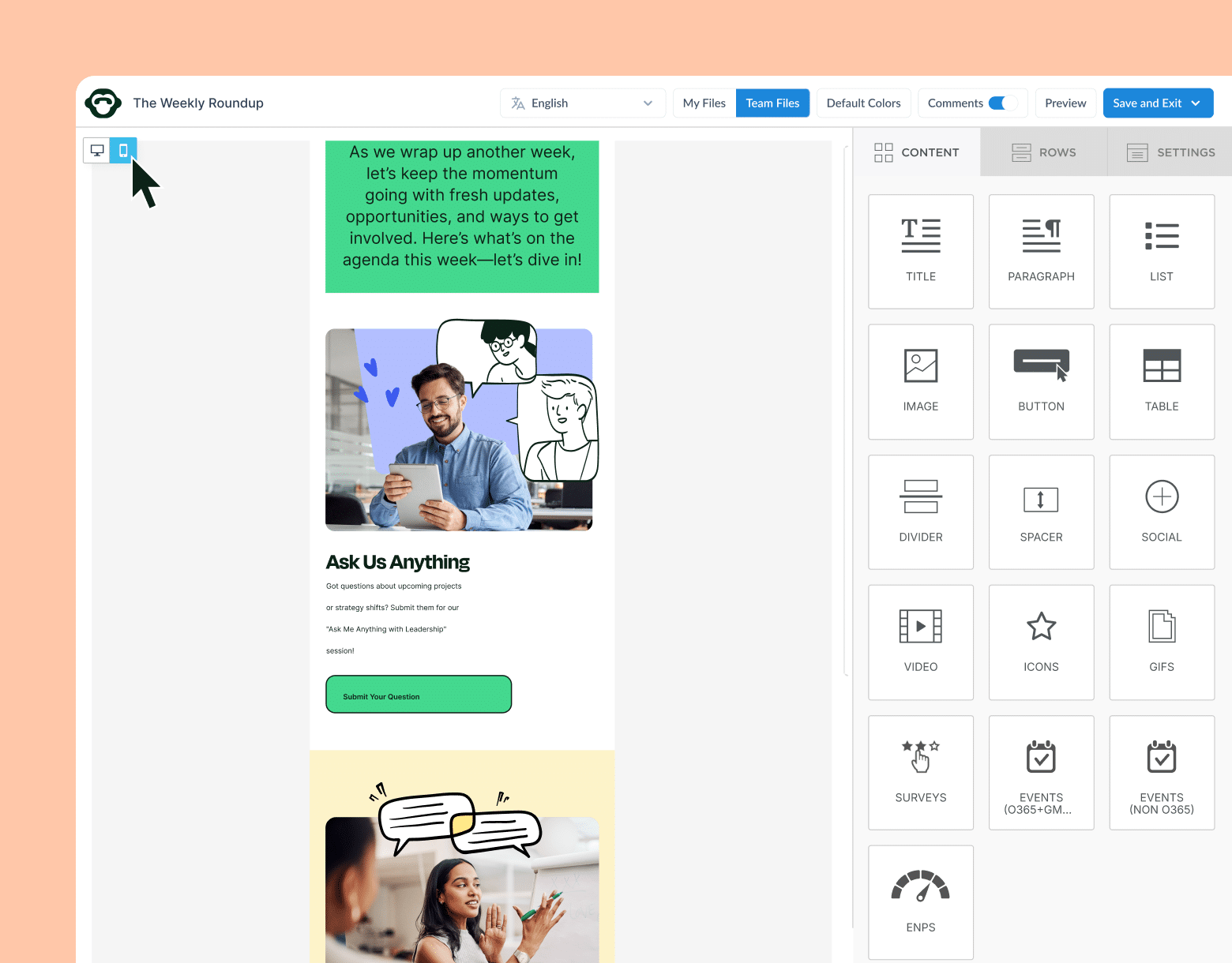
10 Key Ideas for Implementing a Winning Internal Communication Strategy
“Regularly review your strategy. Don’t wait for things to change to drive the review; set aside a time at regular intervals to make sure the strategy still aligns with the organisation’s goals and your internal audience’s preferences. Make changes based on the analytics you’ve captured and sense check them against verbatim feedback – employing the support from a working group will go a long way.” – Dave Purcell, Internal Comms Expert
Even highly successful organizations can struggle to maintain alignment and momentum. With all the change experienced as 2025 kicked off, an effective internal communication strategy ensures timely, clear, and engaging messaging that keeps everyone on the same page.
To achieve this, focus on integrating these essential elements into your strategy:
1. Define the strategic purpose behind internal communication
Clarify why internal communication exists in your organization—whether to drive engagement, enable transparency, or align teams with business goals.
Why it matters: A defined purpose ensures all communication activities reinforce broader organizational objectives, not just day-to-day information sharing.
When to leverage: Before designing any new internal communication plan or revisiting an existing strategy.
Measuring impact: Track employee alignment with company mission and communication objectives through surveys and feedback.
PRO TIP: Use ContactMonkey’s Employee Feedback Features to measure how well employees understand and connect with your communication purpose.
2. Align communication goals to business objectives
Tie every internal communication goal directly to business priorities such as employee engagement, innovation, retention, or change adoption.
Why it matters: Alignment ensures communication drives measurable outcomes that contribute to organizational success.
When to leverage: During strategic planning cycles or after leadership team goal-setting meetings.
Measuring impact: Assess how internal communication goals correlate with key business metrics like retention, productivity, and satisfaction.
PRO TIP: Track goal performance inside our Analytics Dashboard Feature for a real-time view of communication’s business impact.
3. Establish messaging pillars based on strategic themes
Identify 3–5 overarching themes—such as trust, innovation, diversity, or growth—that will consistently guide messaging across all internal communication channels.
Why it matters: Messaging pillars ensure strategic focus, build narrative consistency, and prevent mixed signals.
When to leverage: At the start of your internal communication strategy planning and after any business model shifts.
Measuring impact: Pulse-check employee recall of key themes using quick pulse surveys or quizzes.
PRO TIP: Integrate messaging pillars across ContactMonkey’s employee email templates to reinforce consistency effortlessly.
Watch ContactMonkey LIVE in action
Join live demo
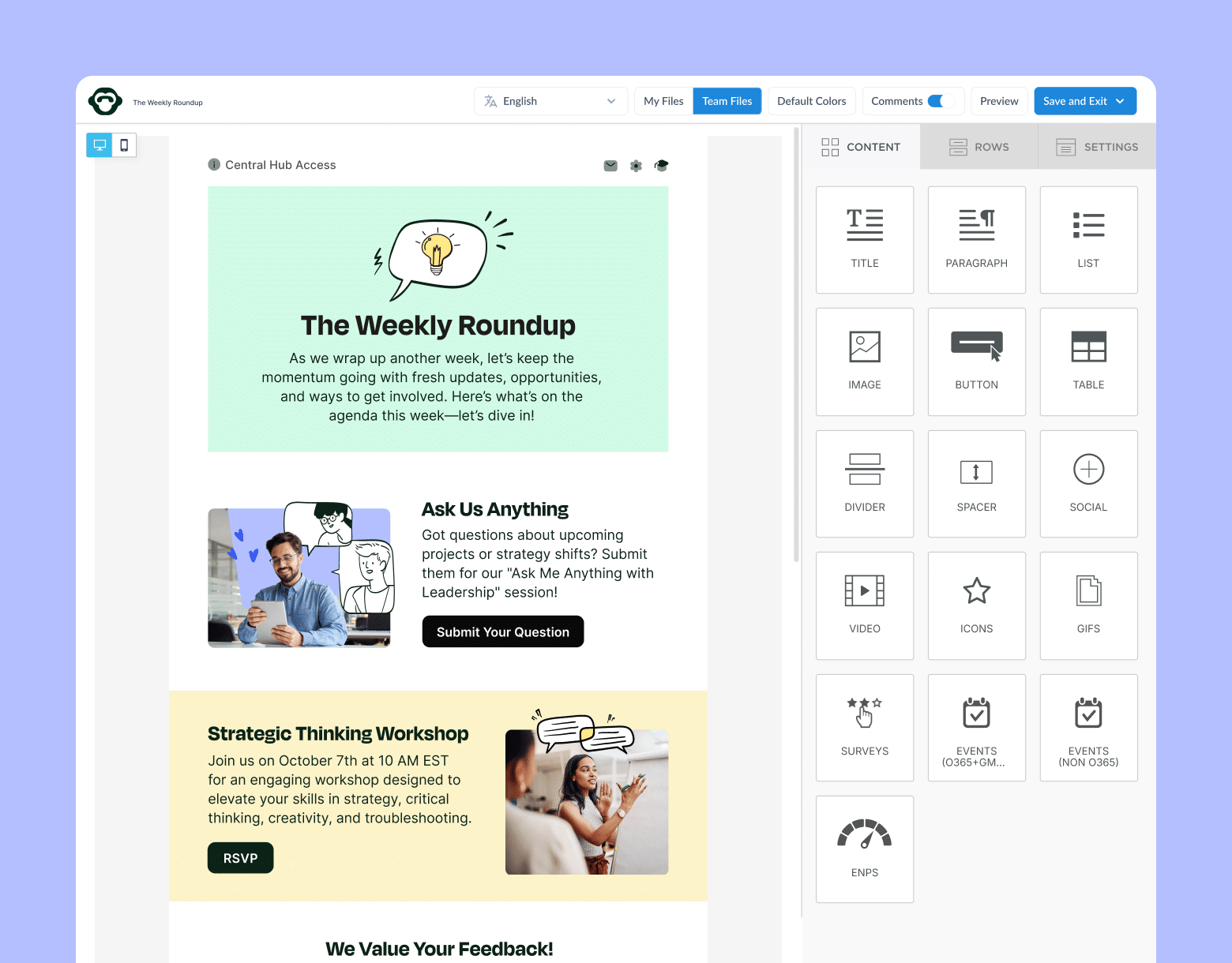
4. Prioritize and map internal audiences based on strategic importance
Define your key employee groups (by location, level, function) and tailor messaging priority depending on strategic initiatives.
Why it matters: Different groups drive different business outcomes—prioritizing messaging keeps strategic audiences engaged and informed.
When to leverage: Before major initiatives like reorganizations, mergers, cultural transformations, or digital transformations.
Measuring impact: Monitor engagement and initiative success rates across priority employee groups.
PRO TIP: Leverage ContactMonkey’s segmentation feature to target communications by audience importance without duplication.
5. Build a strategic communication roadmap
Develop a timeline that ties major business events, change initiatives, and employee milestones to communication touchpoints.
Why it matters: Proactive communication planning builds trust, reduces surprises, and enhances clarity.
When to leverage: During annual business planning or when launching major organizational strategies.
Measuring impact: Compare engagement and initiative adoption rates for communications mapped on a strategic timeline versus ad-hoc messaging.
PRO TIP: Schedule communications directly in ContactMonkey’s email tool aligned with your strategic calendar.
6. Create governance to protect strategic messaging
Define decision-makers, approval processes, and escalation paths to ensure message discipline across teams and geographies.
Why it matters: Without governance, strategic messaging becomes diluted, inconsistent, and less credible.
When to leverage: As soon as you create your internal communication strategy framework or whenever new regions or departments are added.
Measuring impact: Audit message consistency across different departments and teams.
PRO TIP: Centralize communication templates and workflows in ContactMonkey to maintain message governance easily.
7. Invest in feedback mechanisms to shape future communication strategies
Systematically gather, analyze, and act on employee feedback to keep your internal communication plan aligned with evolving employee needs.
Why it matters: Communication strategies that adapt to real-world feedback stay relevant, respected, and impactful.
When to leverage: After major initiatives, quarterly communication reviews, or during annual engagement surveys.
Measuring impact: Track sentiment shifts and participation rates in feedback channels.
PRO TIP: Add embedded employee engagement surveys and feedback loops into every ContactMonkey email campaign to capture insights instantly.
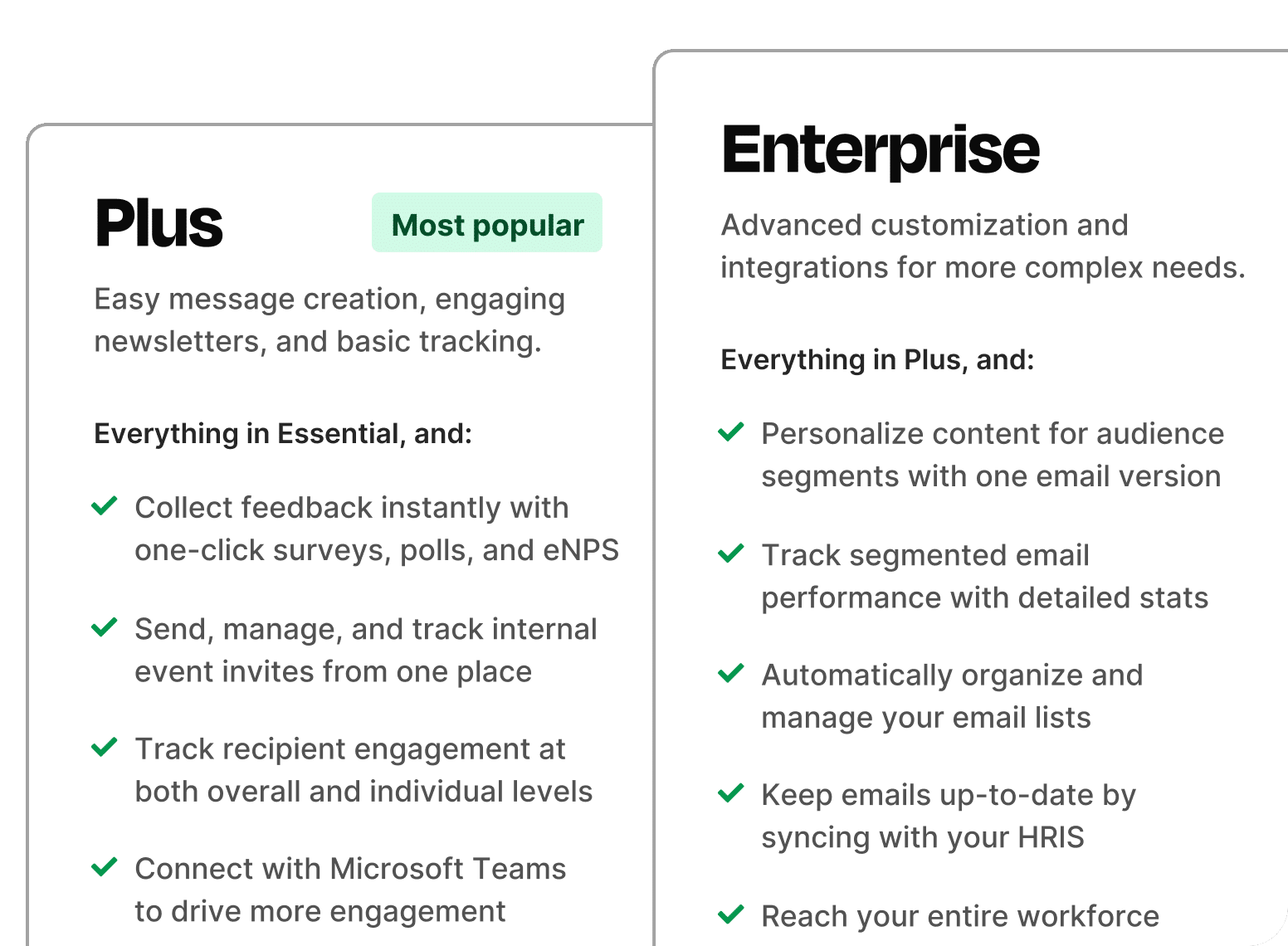
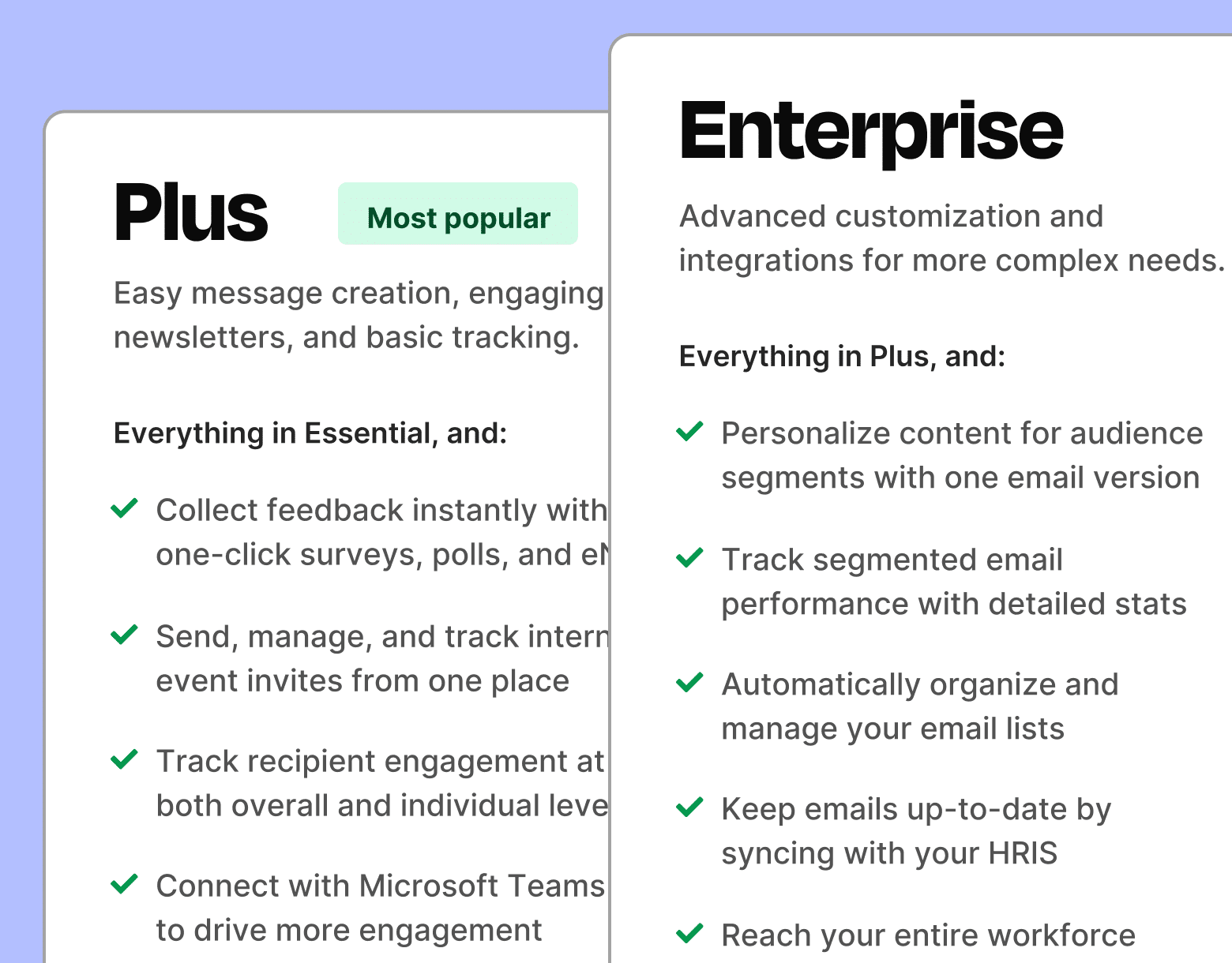
8. Focus on building a culture of two-way communication
Position communication not just as a top-down directive but as a dialogue where employee voices influence leadership thinking.
Why it matters: Two-way communication fosters psychological safety, drives engagement, and builds trust.
When to leverage: Always—particularly during periods of organizational change, uncertainty, or cultural transformation.
Measuring impact: Measure employee participation in feedback mechanisms and their perception of being heard.
PRO TIP: Embed polls, comment boxes, and pulse checks into your ContactMonkey communications to encourage authentic employee input.
9. Use storytelling to connect strategy to everyday employee experiences
Craft narratives that show how corporate goals and strategies connect to employees’ daily work and personal purpose.
Why it matters: Storytelling in internal communications humanizes strategy, making it relatable, inspiring, and memorable.
When to leverage: When launching new strategies, celebrating milestones, or driving cultural shifts.
Measuring impact: Survey employee understanding of how their work links to larger strategic goals.
PRO TIP: Include storytelling modules inside employee newsletters to highlight employee contributions to company strategy.
10. Treat internal communication as a strategic function, not a support service
Position internal communication as a critical business driver with a seat at the leadership table—not merely an information distributor.
Why it matters: When internal communication is valued as strategic, it receives the attention, investment, and respect needed to drive true business impact.
When to leverage: During leadership team discussions, budgeting periods, and organizational redesigns.
Measuring impact: Track executive sponsorship, resource allocation, and cross-functional influence of the internal communication team.
PRO TIP: Pull reports from ContactMonkey to demonstrate internal communication’s contribution to strategic goals in leadership reports.
7 Steps to Building an Effective Internal Communication Plan
Building a solid internal communication plan makes sure that your strategy can be executed effectively. Here’s how to create a winning comms plan:
1. Set measurable objectives that align with company goals: Define what you want to achieve with your internal communication efforts. Whether you’re increasing employee engagement or improving attrition, set specific, measurable goals.
2. Segment your audience for better targeting: Understand who you are communicating with. Different employee segments (full-time, part-time, remote, or freelancers) may have different needs, and your internal communication plan should reflect this by segmenting your audience accordingly.
3. Choose internal communication channels your employees prefer: Select the most appropriate internal communication channels—email, intranet, video, or collaboration tools—and consider your audience’s preferences to maximize engagement. Learn how to create an internal comms channel matrix, to keep on track strategically.
4. Write content that speaks your employees’ language: Focus on creating clear, concise, and relevant messages that resonate with employees. Personalizing these messages based on your audience can enhance their impact.
5. Collect and act on employee feedback regularly: Regularly solicit employee feedback using internal communication surveys to gauge the effectiveness of your messages and identify areas for improvement.
6. Use analytics and automation to refine your strategy: Use employee engagement software designed specifically for internal communications to track, analyze, and optimize your efforts. This ensures you’re making data-driven decisions and continually improving your strategy.
7. Set benchmarks and measure what matters: Use internal communication goals and KPIs to assess whether your plan is effective. Analyze metrics such as email open rates, employee feedback scores, and platform engagement to refine your strategy.
For an in-depth look into building an internal communications plan, << check out this guide.
Plan like a pro: 2025 Internal Communications Calendar
Map out key dates and plan for your success.
Get the guide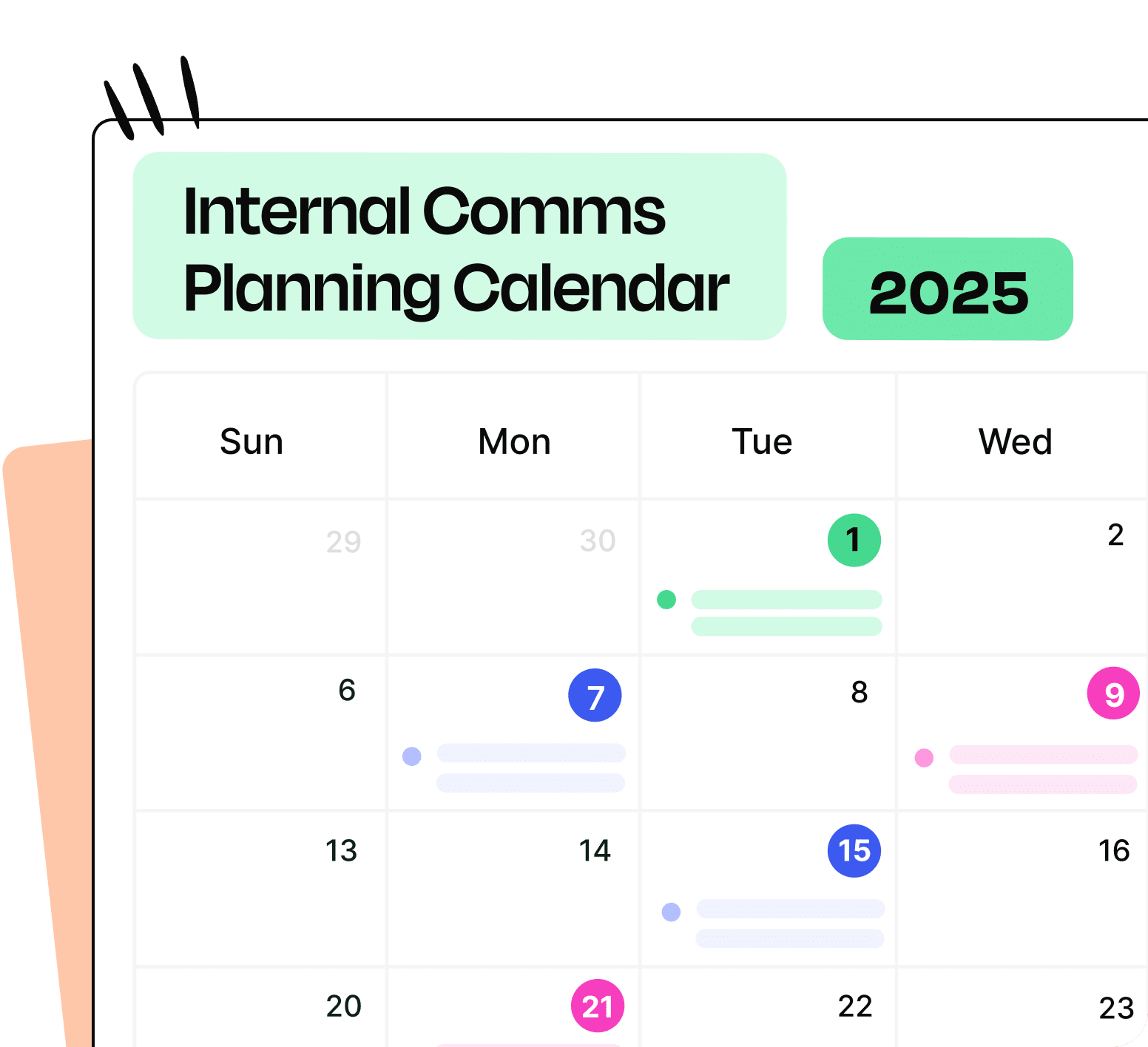
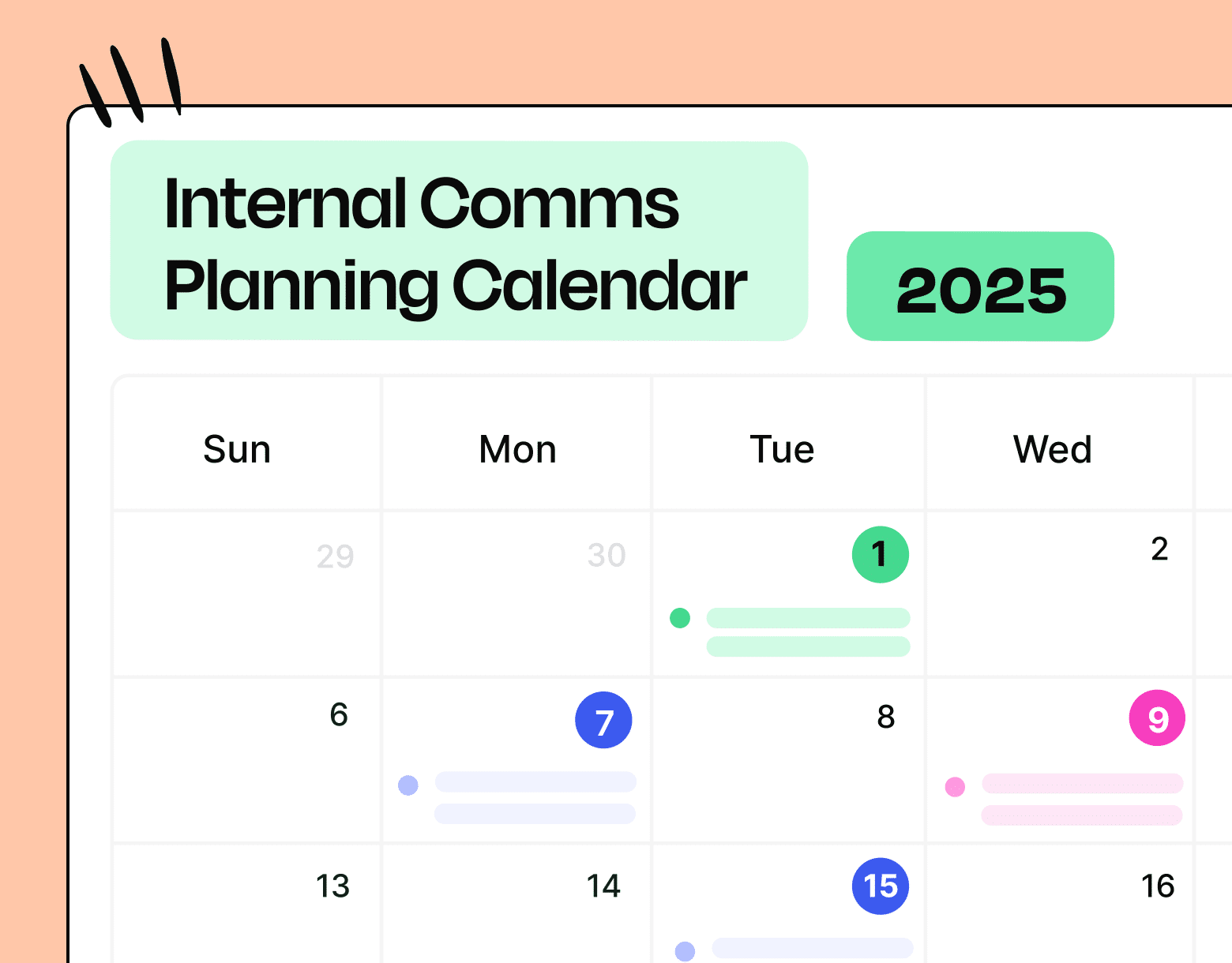
Why You Need an Advanced Internal Communication Tool to Execute Your Strategy
As your organization grows, so do the demands on your internal communication strategy. If you’re finding it difficult to keep your employees informed, aligned, and engaged, it might be time to consider an advanced internal communication tool. Here are the signs that your current methods are no longer enough and a summary of how ContactMonkey can help:
Inconsistent communication: Missing deadlines or irregular updates cause confusion.
Solution: Automate and schedule messages with ContactMonkey’s internal communication software, so important updates are sent consistently and reach all employees on time.
No engagement tracking: Without metrics, it’s hard to know if messages are effective.
Solution: Use ContactMonkey’s analytics to track email opens, clicks, and engagement and gain visibility into employee interactions with your internal communication tools.
Lack of audience segmentation: Sending the same message to everyone reduces relevance.
Solution: Use ContactMonkey’s segmentation to target specific employee groups, ensuring tailored, relevant internal communication email examples for each audience.
Over-reliance on email: Exclusive email use can overwhelm employees.
Solution: Diversify your communication approach with ContactMonkey’s multichannel options, including email, surveys, internal communication video, and SMS communications to reach employees through the channels they prefer.
No employee feedback: Minimal feedback indicates poor engagement opportunities.
Solution: Use ContactMonkey’s internal communication survey features to create quick, easy-to-complete feedback forms for employees, encouraging more input and insight into your internal communication strategies.
Growing communication complexity: Manual processes can’t scale with a growing company.
Solution: Streamline complex internal communication strategies with ContactMonkey’s automation features.
Dropping employee engagement: Low engagement signals a communication breakdown.
Solution: Use ContactMonkey’s real-time feedback tools to improve communication, identify problem areas in your internal communication plan, and take steps to re-engage employees with more targeted, relevant content.
Explore how ContactMonkey can help you bring your internal communications strategy to life with one of our IC experts! Book a free demo, today and get your questions ready for answers.


